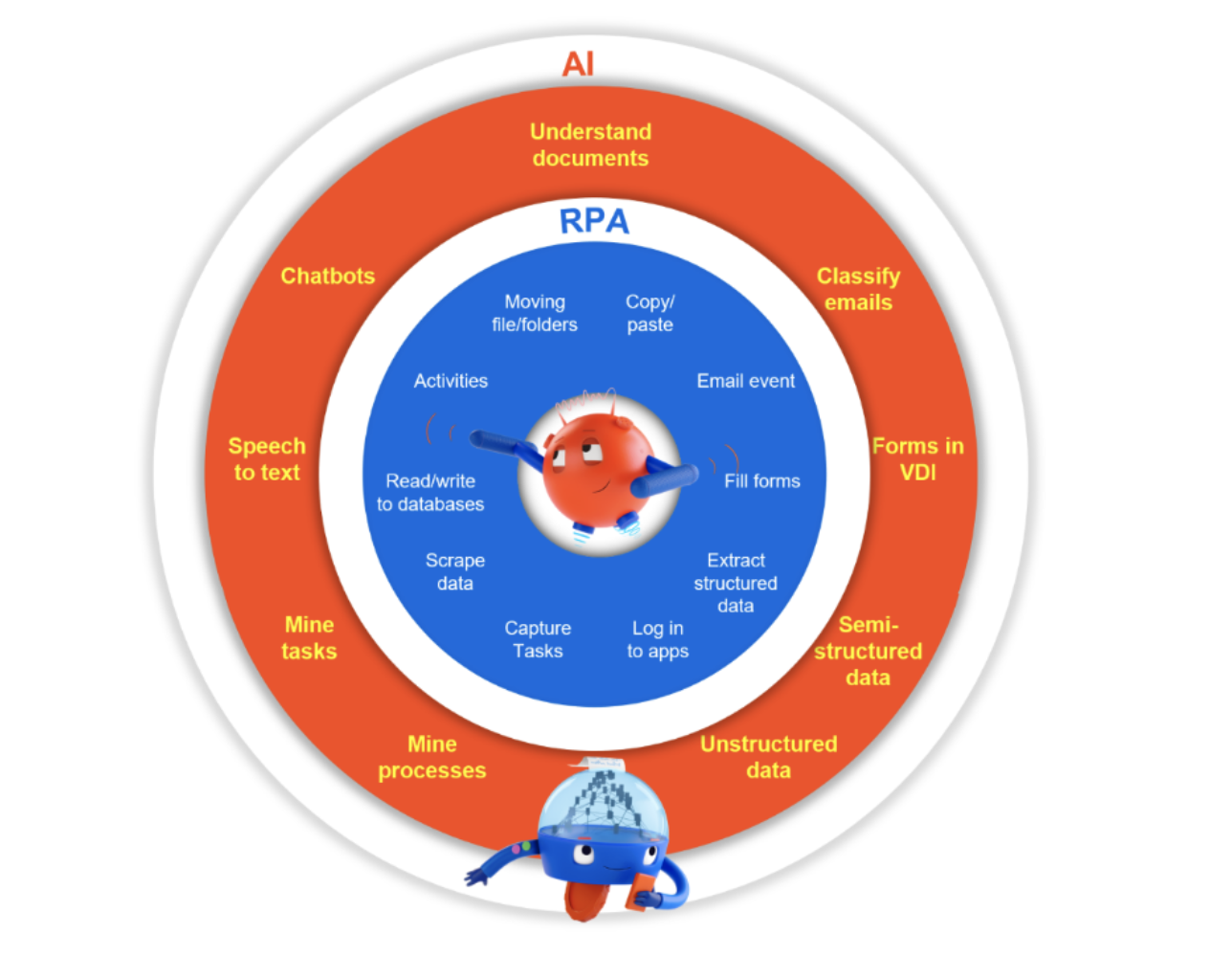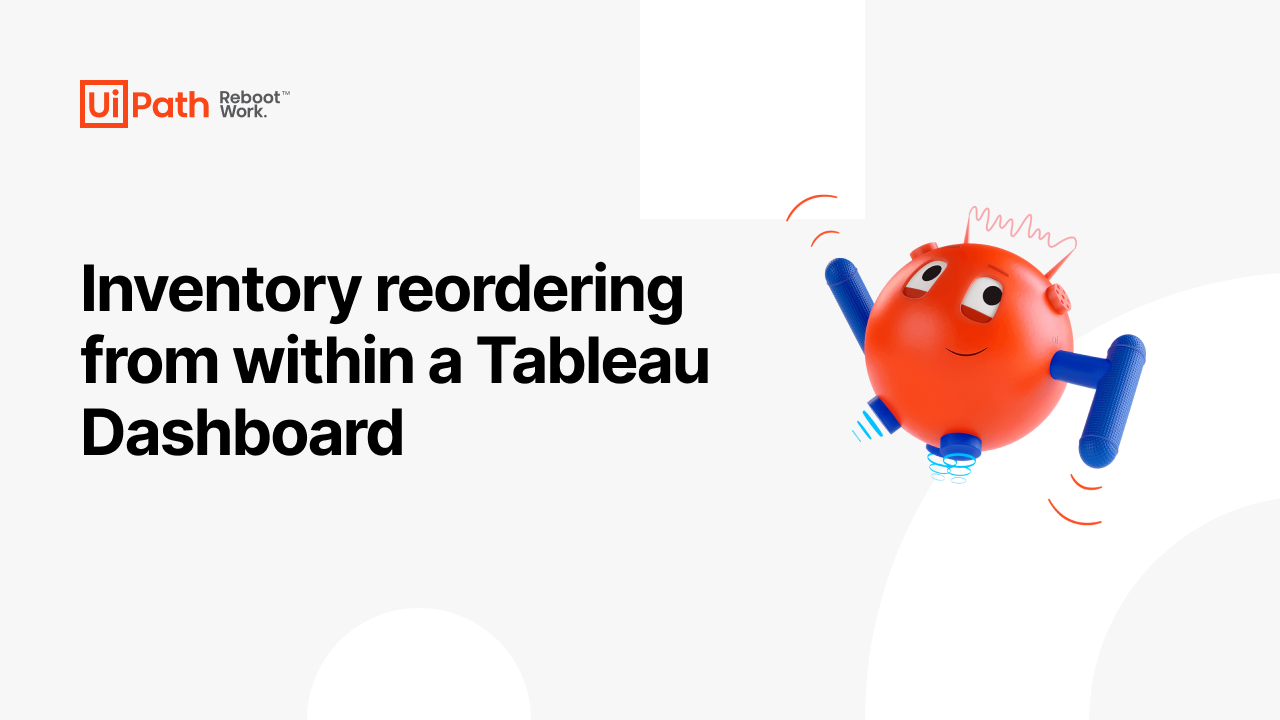A Harvard Business Review (HBR) report surveyed 729 HBR readers to better understand the challenges organizations face in becoming agile, innovative, data driven, and truly competitive. According to the report, 86% of respondents say extracting new value and insights from enterprise data is “very important.” And 75% say it’s “essential” to deliver actionable intelligence to employees enterprise wide.
Clearly, deriving more value from data, making better decisions, and acting on them faster, is mission critical for most organizations.
Whether you are already on the path to being a fully data-driven organization, or you are early in your journey, we’ve identified five ways automation can help you realize the full potential of your analytics and business intelligence (BI):
Improve data quality
Analyze data from any system
Take action when and where you make decisions
Use BI data in complex business and IT process automations
Democratize BI through automated reports
1. Improve data quality
Using bad data in predictive models and analytics can lead to the loss of confidence from your BI consumers and have a big financial impact on your business. According to a Smarter with Gartner article, the average financial impact of poor quality data on the organization is estimated to be on average $15 million per year.
Data preparation is an important step to identify data quality issues ahead of analysis and to aid data repair. According to Forbes, “data scientists spend around 80% of their time on preparing and managing data for analysis,” leaving only 20% of their time for analysis.
Automating data collection, cleansing and data repair can significantly reduce the time analysts spend on preparing data. Proprietary products like Tableau Prep are purpose-built to automate tasks like data collection, cleansing, and labeling.
Robotic process automation (RPA) offers a fast, reliable way to extract data from multiple systems, perform initial quality checks, and compile data into a single file or report—ready for preparation and analysis.
For example, ONCE, a charity in Spain that supports people with visual impairment, uses RPA to track the lottery ticket stocks distributed to 28 distribution centers. Using UiPath software robots to log into the system, pull out the required data, and enter it into a master report, ONCE can now perform this task in a fraction of the time it used to take. Human involvement is reduced to a minimum, with only final checking and oversight required. Report generation is now weekly instead of monthly and employees have additional time to focus on higher-value tasks.
Previously, employees were doing all of this manually click-click-click as they logged into the system, opened the [Microsoft] Excel file, copy-pasted the information, etc. Just so that they could understand stock levels. We told them that we could have a robot doing this for them and they were delighted.
Emilio Campin, Project Manager, ONCE
Beyond data extraction and preparation, automation can play an equally important role in improving underlying data quality by avoiding errors introduced by manual data entry.
RPA supports any number of repetitive tasks to ensure data quality remains high while automating advanced processes like the digitization and collection of data. Data extraction from documents and data synchronization are two popular ways to automate data management.
Brent Council in the United Kingdom (UK), for instance, uses RPA to automate their rent change process from one that previously relied on a lot of manual effort to capture and update. Employees described the manual process as “mind numbing” and it inevitably led to errors in the data. The council automated the process with UiPath and rolled it out within six weeks. A single rent change that used to take a staff member over four minutes to process manually, now takes less than 40 seconds.
We had highly skilled assessment officers having to spend hours copying and pasting information to make the rent changes…We found that automating the rent change service dramatically improved the quality of our data. We eliminated the errors that creep in through manual data entry.
Manjula Pindoria, Digital Workstream Lead, Brent Council
This project has been so successful that many other teams in Brent Council have asked to deploy RPA for their data cleaning activities, ensuring up-to-date and accurate information in the core business systems. Read the full story to learn the many ways Brent Council is using automation.
2. Analyze data from any system
Organizations around the world continue to rely on legacy systems and mission-critical business applications that do not have APIs, like mainframes. In fact, according to a global mainframe market report, “70% of banking corporate data still resides on the mainframe.” And the global mainframe market continues to grow. But extracting that data for analysis can be very challenging and often requires manual work.
With RPA, you can extend the data reach of BI and analytical tools into legacy systems, virtualized environments, and systems that don’t have APIs. Automation can help, whether you want to extract and analyze core banking information or gather exchange rate data from a website into a format analytics tools can understand.
Brent Council also uses RPA to flow data from their legacy systems into their newer digital systems:
Like any council, we have a lot of legacy systems. Making sure that data can flow seamlessly between our legacy systems and our newer digital systems is essential. RPA can be quickly programmed to talk with these systems and effectively extract data from one, validate it and put it into another. It’s fast, efficient, and cost effective.
Manjula Pindoria, Digital Workstream Lead, Brent Council
Additionally, artificial intelligence (AI)-powered RPA can wrangle unstructured data like emails, PDFs, images, handwriting, and scanned documents for analytics. The unstructured data is consolidated into a single data source, like a line-of-business system, spreadsheet, or database, and immediately ready for analysis.

The Hollard Group, a South-African insurer, did just that. The company, which receives 1.5 million emails a year from insurance brokers, was manually processing each individual email and attachment to identify the context and classify the content. This process requires high accuracy and must maintain strict compliance with service-level agreements (SLAs) and regulatory and statutory provisions.
The company implemented an end-to-end automation solution to improve the speed and accuracy of the process. The solution included machine learning (ML), natural language processing (NLP), intelligent optical character recognition (OCR), and analytics capabilities in a single user interface.
The Hollard Group saves 2,000 work hours per week and lowered the cost per transaction by 91%. Processing is performed in real time, with 98% of cases handled autonomously by robots 600% times faster than before.
3. Take action when and where you make decisions
Turning decisions into actions is the last mile of the analytics pipeline. It’s where the knowledge worker acts upon the analysis produced by their BI platform.
A recent Forbes article says it best, “The idea of providing business intelligence when and where it’s most illuminating is incredibly compelling. But the prospect of enabling users to act immediately on these insights is even more powerful.”
Leading analytics platforms are starting to include one-click calls to action alongside the related analytics dashboards while leveraging information from the BI tool to trigger downstream business processes.
Imagine, for example, a supply chain analyst reviewing inventory data in a Tableau dashboard. The stock levels are flagged as too low for a certain item. The analyst can trigger a purchase request to reorder the stock item that needs replenishing directly from within the Tableau dashboard. Similarly, an IT system administrator can launch a software robot to investigate an incident without leaving the IT service management dashboard.

And for highly structured, low-risk use cases, automation can initiate the downstream business processes directly from the analytics platform. For instance, it becomes easy to automate the daily task of sending marketing emails to a list of customers identified by the regular analytics process.
Beyond these use cases, the application for organizations is far reaching. In supply chain management alone, stock managers, logistics teams, suppliers, finance, and accounting team members could all benefit.
4. Use BI data in complex business and IT process automations
Organizations are embracing analytics and data science to gain insights into their business and make more informed decisions. BI data can also drive better decisions as part of an advanced business workflow.
Extracting data from your BI system would (in most cases) require either manual extraction or new code. But with RPA, BI data extraction can be quickly automated.
For example, finance departments can report and act on invoice payments reaching their maximum payment terms. Using information from the automatically downloaded BI report, an RPA robot can automate reminders and escalations to ensure the payment is made within the payment terms.
Information about IT assets, including asset owners and utilization stats, that are tracked in reports can be easily extracted by a UiPath robot and used to perform IT maintenance and asset management. IT automation with UiPath streamlines challenging tasks like patching critical servers and increasing or decreasing IT resources based on real-time demand analytics.
These core IT admin processes are further optimized by UiPath with out-of-the-box activities that speed up development and reduce the effort to maintain workflow automations.
Automating BI data extraction, and then utilizing that data in your complex business processes helps your organization make faster and better decisions.
5. Democratize BI through automated reports
Automation can aid the democratization of business intelligence, streamlining the enterprise-wide sharing and consumption of insights about your business. Imagine starting the day with a summary combining reports and data visualizations from all the different places the information might ‘live’. These insights will cover unexpected changes in your customer behaviors, demographics, and conversion rates. And you’ll be empowered to take action and improve your key performance indicators (KPIs).
With RPA, your company can have daily reporting while saving time, improving productivity, and increasing accuracy:
Automating data export
Assembling BI dashboards or reports into consumable formats like PDFs and Microsoft PowerPoint
Distributing via channels such as email, Slack, or Microsoft Teams
Automated reports can be generated on a regular predictable frequency, like every Monday and may also be triggered by certain events, like a logistics backlog that has increased to a critical level that must be resolved.
For instance, one company leverages RPA to streamline and improve the accuracy of their profit and loss (P&L) reporting. Every day, a UiPath robot is triggered to gather the required data, validate it, and generate the final report. The robot then emails these reports to the front office team for review before they are uploaded into the head office web application.
By democratizing BI through automation, you can free your business analysts and executives from spending their time combing through and exploring data. Instead, they focus on making the right decisions for the business based on what their data is telling them.
Drive more value from your data, act faster, and make better decisions
By applying automation to BI data using the five ways discussed in this article, your people will be able to focus on making better decisions, act faster on data-driven insights, and spare your business from costly mistakes.
Read more about how UiPath robots can act on data-driven insights and accelerate decision making, directly from analytics platforms like Tableau dashboards, with native integrations.
And find out how analytics can aid your automation projects to better align business outcomes.



